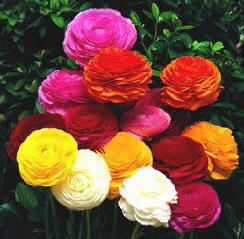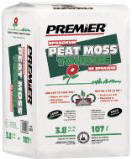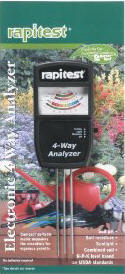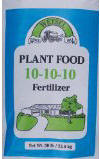If you are looking for a good financial investment in your garden, you can't go wrong with flowers that are grown from bulbs. Once planted, bulbs will provide a rainbow of colors (Figure 1) in your garden next year and for years to come.

Figure 1 - Rainbow Ranunculus
The planting of hardy spring flowering bulbs is best accomplished in the fall months. You can plant most bulbs as long as the ground has not frozen, but always read and follow the planting instructions that come with each package of bulbs.
Soil Preparation:
As with most garden flowers it is important to prepare the soil correctly prior to planting. Making sure that the soil drains well is very important, as most bulbs are prone to rot if the soil is to wet. Soils that are high in clay can be adjusted by adding organic material such as peat moss (Figure 2) or compost. Work the organic material into the soil to a minimum of 12 inches below the surface.

Figure 2 - Peat moss
Phosphorus should be mixed into the soil to enhance root development. Use a superphosphate or bone meal (Figure 3) mixed into the soil below the bulb, about 8 to 10 inches deep as this is the location of where the roots will be and where the fertilizer will be absorbed. Then apply a small layer of soil above the fertilized soil so that the bulb is not in direct contact with the fertilizer.

Figure 3 - Organic bone meal
Note: If you have small burrowing animals on your property, such as gophers or chipmunks the use superphosphate as bone meal will attract the animals to the bulbs.
If you do not remove your bulbs after flowering then it is important to continue fertilization.
For spring flowering bulbs - in the spring (as soon as the shoot is visible) and in the fall, for every ten square feet of garden, create a mixture of two cups of superphosphate combined with five tablespoons of 10-10-10 soluble fertilizer (Figure 4).
To avoid bulb rot do not add fertilizer to bulbs once they have started to flower.
The soil pH range should be tested (Figure 6) to determine if lime (Figure 5) is needed to reduce the acidity of the soil. The correct pH range for bulbs is 6 to 7. An acid soil will be detrimental to hardy blooms.

Figure 5 - Garden lime

Figure 6 - Soil pH test meter
For bulbs that flower in the summer and fall – as soon as the plant is visible commence fertilizing monthly until the plants start to flower. Use seven tablespoons of 10-10-10 soluble fertilizer (Figure 4) over a twenty square foot garden area.

Figure 4 - 10-10-10 fertilizer
Additional information on Planting Bulbs
Part 2 – Planting Location, Planting Depth;
Part 3 – Watering, Removing Foliage;
Part 4 – Staking, Mulching, Storing;
